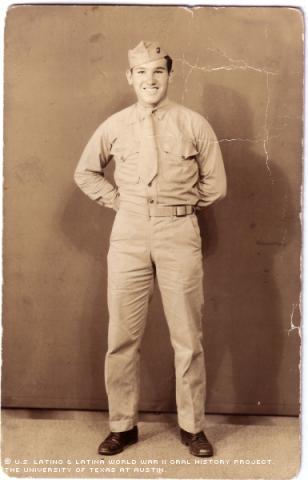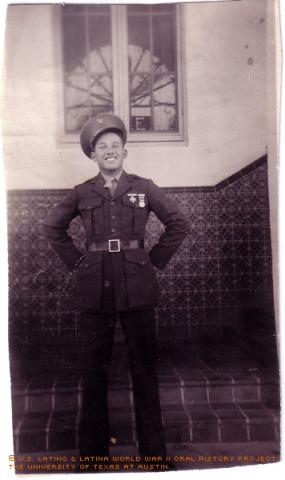

By Elizabeth Egeland
Private First Class Edward Romero listened as his platoon was briefed on its next mission. He’d already fought with the Marines in the Marshall Islands and Saipan, but was about to embark on an even more dangerous operation -- the Battle of Iwo Jima.
"Tomorrow you will be landing and some of you men will be killed. I might even be killed," an officer told the second platoon of F Company, which would be in the first assault wave on Iwo Jima. "Some of you will be wounded and some of you will come back, but we have a job to do."
Romero was only 19, but he says he was ready for the battle -- he was familiar with what the soldiers of F Company of the 2nd Battalion, 23rd Marines, 4th Marine Division had to do.
"I was prepared, and I turned to God and I talked to myself: 'I have come this far, and by the grace of God, I will probably make it also,'" recalled Romero, adding that he kept faith he’d prevail throughout the war, believing God would pull him through the darkest of times.
At 16, Romero knew he wanted to join the Marines. He’d been forced to quit school six months into high school. Times were hard and his family needed his help. The teenager served as a janitor and an usher at a movie theater in Miami, Ariz., before his family moved to Mammoth, Ariz., where he worked as a dryer operator in a mill -- a dryer operator dries the concentrates from the mill on a dryer.
While visiting his sister during Christmas in Tucson, Ariz., in 1942, Romero saw an advertisement about the Marines.
"At that moment, instinct probably, I went up to the recruitment office and signed up for the Marines, but they wouldn't take me because I was only 16 years of age," Romero said.
His 17th birthday was only weeks away and he could sign up then, with his parents' consent. His father signed without hesitation and his mother finally relented.
"She took it very hard that I wanted to go into the service," he said.
His first assignment: Marine Corps Depot in San Diego, Calif. The entire town came to see him off.
"It was nothing but a one-way street," he said of his hometown. "The whole town of Mammoth came to wish me Godspeed and goodbye. ... Mom ... cried very, very much."
Romero soon transferred to Camp Pendleton near Oceanside, Calif., where the young Marine went on maneuvers and started amphibious training.
By Christmas of 1943, Romero was about to be sent on his first mission: gaining control of Roi-Namur, in the northern part of the Kwajalein Atoll. The islands of Roi and Namur, linked by a short causeway, are so close that they counted as a single target. Roi-Namur was the primary Japanese air base in the Marshalls. It was there that Romero, a rifleman and ammunition carrier for a machine-gun squad, first met the Japanese in combat.
"As they started shooting at us, I threw myself on the ground, and the machine gun squad leaders that were ahead of me kept raising and firing the machine gun and I tried to reach them," Romero said.
He crawled into a ditch other Marines had gone through ahead of him, but as he made a turn, he ran into a Japanese fighter.
"I came face to face with him," Romero said. "I happened to have my rifle in front of me ... That was the first man I ever killed."
After two more days of fighting, the islands were secure and the troops returned to their base in Maui, Hawaii, for further training.
On June 14, 1944, the platoon moved to the next battle -- on Saipan. As the men arrived, Romero witnessed more death. He himself had several close calls while serving.
"By the grace of God I am still alive," he said.
While mopping up in Saipan, Romero passed an opening where he heard a voice calling out "Help" in Spanish. Romero followed the voice and saw where the man had been shot in his legs.
Soon, a fellow Marine, Ralph Miller, climbed down the hole to the voice, carrying a knife in his mouth for self-defense.
"No sooner did he get in that opening did he slip all the way down to the bottom," Romero said. "I looked down in there and I heard a lot of scuffling down there. After that I heard an explosion."
Romero called to Miller, who said he'd be right up. Miller brought up the Spanish-speaking man; Miller's knife was covered with blood.
As it turned out, the Spanish-speaking man was from New Mexico and his son-in-law was the Japanese soldier holding him captive in the hole. The soldier had said he’d kill a Marine, and then kill the father-in-law. The soldier tried to detonate a hand grenade on Miller's head. However, the "grenade fell back, and he [Miller] ripped his belly up with that knife," Romero said.
The man from New Mexico had been working on the island before the war and wasn’t allowed to leave after war broke out. The man, telling Romero he was Catholic, rewarded him with a religious medal that had the Virgin Mary on one side and Jesus on the other.
"I carried that medal with me for many years, and I don't remember what happened to it," Romero said.
Once Saipan was secured, Romero's unit regrouped and landed on the Island of Tinian.
In a letter written to the Project after his interview, Romero recalls his experiences after the Battle of Saipan:
"... After taking the Island of Tinian, we sailed back to Maui, where we started training for the battle of Iwo Jima, where I saw the raising of our flag. God Bless America!"
As in past battles, Romero's platoon would be in the first wave to hit Iwo Jima.
Romero says he gained a lot of comfort from his comrades. While traveling to the island in an amphibious tractor, he knelt with platoon Sgt. Leonard Kelly, known affectionately as "Moose" for his scruffy beard.
"As we were kneeling in the amphibious tractor, out of his pocket in his outfit he took a little prayer book," Romero said. "... He held that prayer book and he read an Our Father, a Hail Mary ... and I read it with him and he put that book in and about that time, we came onto the beach."
Romero recalls in his letter that During the Battle of Iwo Jima, he and his troop began to advance amidst shelling and machine-gun fire:
"I noticed my platoon sergeant ahead of me was hit in the head. A machine gun dugout was in my right side a few feet away. I stood up to see what I could do, as my B.A.R. (Browning automatic rifle) would not fire and I had dropped my hand grenades."
After calling on a marine with a flamethrower to stop the gunfire, Romero was hit by shrapnel when a shell exploded nearby, he writes. He was hospitalized on a ship but soon returned to battle.
He was injured and hospitalized a second time with a blast concussion, subsequently getting transferred to the U.S., where he did guard duty until he was discharged in November of 1945.
Romero returned to Arizona and began to work in carpentry. He married Isabel Herrera in 1951 and the couple had six children: Percilla, Carmen, Benjamin, Robert, Larry and Steven.
At the age of 77, Romero's World War II memories -- of life and death and his continuous faith in God -- are still vivid.
"It's amazing what a lot of men went through -- their courage, their bravery," Romero said.
Mr. Romero was interviewed in Tucson, Arizona, on January 5, 2003, by Joe Olague.

